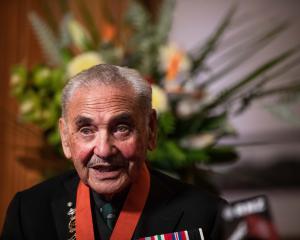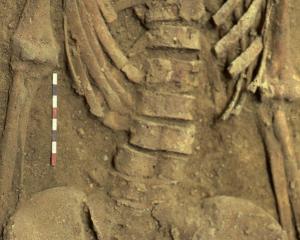A century after the New Zealand Government declared April 25 a holiday in recognition of the dead of Gallipoli, we are still coming to grips with the campaign, writes Shane Gilchrist.

Today thousands of young New Zealand and Australian backpackers, among others, will stretch, rise and join the Dawn Service at the Anzac commemorative site at Gallipoli in Turkey, not far from a war museum where the exhibits include bullets fused together, their mid-air collisions offering a chilling insight into the ferocity of the campaign.
• Anzac Day and other war books
Some 17,000km away, ceremonies around New Zealand will mark 100 years since the first Anzac Day services were held, after the Massey government declared April 25, 1916, a half-day holiday to commemorate those who lost their lives at Gallipoli.
Meanwhile, at Te Papa, two graphic panels are being changed. It seems the fog of war has permeated our national museum.
The exhibition "Gallipoli: The Scale of our War", a collaborative effort between Te Papa and Weta Workshop, requires a little tweaking following recent research by the Ministry for Culture and Heritage (MCH) and the New Zealand Defence Force (NZDF) that shows the total number of New Zealand soldiers who served at Gallipoli in 1915 was more than 17,000.

The revised total doubles the original number of 8556 soldiers stated by British General Sir Ian Hamilton in his preface to the New Zealand official war history of the campaign, The New Zealanders at Gallipoli, written by Major Fred Waite and published in 1919. The implications of a doubling of those who served at Gallipoli? The ratio of New Zealand casualties is almost halved, to 47%. Hence the need to alter those panels: one, comparing New Zealand's casualty rate to other nations, will change from 93% to 47%; the other will be reworked to reflect the revised total who served there.
So far, so obvious. Yes, the changing of Te Papa's presentation could be viewed as a logical swerve on the road of historical research. But digging a little deeper has unearthed a story that is less about war and more about how we navigate our own perception of war.
Concern had already been expressed by military historians about the use of Hamilton's century-old statistics in the exhibition. Their point: there was evidence of much higher Gallipoli numbers, Hamilton historian Richard Stowers having in 2005 published the book Bloody Gallipoli: the New Zealanders' story, in which he calculated almost 14,000 soldiers of the New Zealand Expeditionary Force served in the campaign.
In fact, it was this robust debate that directly led to the multi-agency research project between the MCH and NZDF. Asked why Te Papa decided to use the figure of 8556 in its exhibition, Kate Camp, communications manager for the museum, responded: ‘‘Dr Christopher Pugsley was the historical director of our exhibition and is a well-regarded international authority on Gallipoli. He made the call to use the 8556 figure and at the time that was the only figure with an official source.
‘‘Of course, he was well aware of the debates of higher estimates. Chris knew there was more information to be found. And the discovery of this new information has gone a long way to turning a solid hypothesis into a solid new number. In terms of the panels, they will be replaced in the next few weeks. It takes a while to get the new information written in a way that is clear and user friendly for the public.
‘‘I've talked to Chris Pugsley. He says he doesn't have anything to add. He did say, ‘I was the dinosaur in the room, and I wasn't going to shift until there was something to shift to'.''
Interestingly, following an approach by the Otago Daily Times, Te Papa this week posted a blog by Dr Pugsley on its website: ‘‘As historical director of the ‘Gallipoli: The Scale of our War' exhibition at Te Papa Tongarewa, I was the dinosaur that tenaciously held to the 8556 figure of the total number of New Zealanders who landed on Gallipoli, first published in Fred Waite's [The New Zealanders at] Gallipoli.
‘‘I held out against the higher figures of some 13,000-14,000 succinctly argued for by Richard Stowers in Bloody Gallipoli and by [military historian] David Green at the Ministry of Culture and Heritage. I considered that with the digitisation of the personal files [an Archives New Zealand project that began in 2014] we had the means to establish the actual number and, until that occurred, we stayed with what we had,'' Dr Pugsley writes.
‘‘The casualty graphic used in the exhibition, based on Waite's book, sparked intense debate and a robust interchange between historians and aficionados of the campaign. It led to the New Zealand Defence Force setting up a working party to establish the numbers of New Zealanders who served on Gallipoli.''
Joint forces for project
Regarded as the most comprehensive investigation into the total numbers of New Zealand soldiers who served at Gallipoli, the multi-agency research project began last November.
Utilising the expertise of several military historians, including those who had questioned the 8556 figure, the project benefited from Archives New Zealand's 2014 digitisation of World War 1 military service files, which dramatically increased the number of records that could be easily accessed.
However, military service files alone cannot provide the whole answer. There are still significant gaps in these records and the new total is a conservative estimate, Ministry of Culture and Heritage chief historian Neill Atkinson explains.
‘‘We work with the New Zealand Defence Force quite a lot, particularly in regards First World War material, so we wondered how we might come to some sort of resolution on this question. I don't think we ever thought we'd get a perfect figure, but we wanted to arrive at a figure that would be more widely accepted.
‘‘Initially, there had been talk of going through 20,000 personal military files, of all those people who enlisted in time to have served at Gallipoli. But we wouldn't have necessarily had the resources to do so. Also, a lot of people very familiar with the military files didn't think they would provide the answer. A lot of files don't even mention Gallipoli; there was enough uncertainty there to discourage that approach.''
World War 1 military service files typically recorded a soldier's military career, movements between units, and illnesses, but were less concerned with placing them in a particular campaign or theatre of war. Sometimes that ‘‘Gallipoli box'' simply wasn't checked, Atkinson says.
Rather than searching through every file, the researchers decided on a methodology that instead looked at 2429 service records of the 6th Reinforcements, which left New Zealand on August 14, 1915, and was the last reinforcement echelon to reach Egypt before the end of the 1915 Gallipoli campaign.
‘‘They were the last group of reinforcements with a strong chance of serving at Gallipoli; the ones after them had less chance; the ones before them an even stronger chance,'' Atkinson says.
‘‘The point is, if the 6th Reinforcements showed a high number of Gallipoli service - which they did - that would suggest the overall figure must have been higher.
The analysis (overseen by Statistics New Zealand) showed that at least 76% of these men served at Gallipoli. Still, given military service records alone could not provide a definitive answer, the project was expanded to cross-reference unit administrative files and search for other relevant material. Concurrent to this analysis, NZDF historian John Crawford was certain there must have been other records that provided a window into unit strength, the departure of casualties and the arrival of reinforcements.
A major breakthrough came in January when Crawford discovered the notebooks of the deputy assistant adjutant general (DAAG) of the Australian and New Zealand Division, Lieutenant-Colonel Nathanial William Benjamin Butler Thoms. The meticulously kept records, found at Archives New Zealand, detail the movements of Australian and New Zealand Division soldiers on and off Gallipoli Peninsula during June, July and August 1915, meaning researchers could calculate the total numbers with a much higher accuracy.
‘‘John Crawford was looking for administrative evidence to help answer the same question,'' Atkinson says. ‘‘A number of people had been looking to find similar evidence for quite some time, but the records are in a somewhat messy state, which is perhaps unsurprising given the context of the campaign in which they were created.''
The final figure was reached by adding the results of the 6th Reinforcement research, the numbers estimated to be present in April-May 1915, and the numbers from the DAAG's notebook research.
‘‘We have arrived at something which both the MCH and NZDF believe is a solid figure, one that finally lays to rest that 8556 figure.''
Yet Richard Stowers thought he had done just that a decade ago. The historian whose 2005 work contributed to the Te Papa debate and the subsequent establishment of the multi-agency research party, was overlooked in the recent media clamour. He's used to that, he says.
‘‘I was hurt. But I know why my work wasn't mentioned. I'm not an academic. I'm not funded by the Government. There was also a cone of silence when my work was published a decade ago.''
And, after all, a doubling of numbers sounds so much more emphatic in a headline than an adjustment upwards of a few thousand soldiers: from Stowers' estimate of 13,977 to the latest figure of 17,048.
Stowers' book, Bloody Gallipoli: the New Zealanders' story, was in part driven by a desire to correct the preface to 1919's The New Zealanders at Gallipoli, in which General Sir Ian Hamilton claimed that of the 8556 who served there were 7447 casualties (killed and wounded but excluding sickness), a 93% ratio.
‘‘In my 2005 book I said both New Zealand and Australia had about 57% casualties. To me, that makes sense. Sure, it might vary a bit from that, but not by too much,'' Stowers says.
‘‘It is ludicrous to think New Zealand had more than 90% casualties. We went on to Gallipoli with the Australians on the same day and came off the same day. We occupied a lot of the same trenches, shoulder to shoulder, although when the August offensive developed, the Australians tended to go to the southern sector and we went to the northern sector.''
New interpretations
Matthew Buck, a New Zealand Defence Force historian, says there is a message to be taken from the research project. And it's one that goes beyond any statistical analysis.
‘‘It is that history doesn't stand still. When new evidence arrives, it allows the possibility of new interpretations, including quite radical rethinks,'' he says, adding any revision of figures has the potential to inform the narrative of Gallipoli; ergo New Zealand's cultural relationship to Anzac Day.
‘‘I think it does affect how we view the campaign. That original 93% casualty rate, quoted using that old figure of 8556 serving personnel, is obviously not credible. No force in history has endured casualty rates like that. Ever.
‘‘The revised casualty figure of around 50% is in line with the other troops who served at Gallipoli; the Australians, British, French and Indians and so on. It shows a rough equality, which is what you would expect.
"That said, 50% is still an extremely high casualty rate, by any stretch of the imagination. First World War battlefields were intensely deadly environments. Such casualty figures can be found for just about every major battle of the First World War, including those on the Western Front.''
In his blog, Dr Pugsley sees other implications in an upscaling of the numbers.
If an estimated 17,000 New Zealanders landed at Gallipoli, that would mean 100% reinforcements over and above the actual fighting strength of the force.
Citing Stowers' casualty figure of 2779 deaths and 5212 wounded (including multiple incidents of wounding to the one person, as well as death), Dr Pugsley says this would comprise 7991 battle casualties, almost equivalent to the fighting strength of the New Zealand units ashore. And that doesn't include those evacuated because of sickness.
‘‘It is sobering to think that despite the 8500-strong NZEF component receiving some 8500 reinforcements, battle casualties and sickness and disease meant that it was just over half-strength at the time of the December evacuation: a raw casualty rate of 150%.''
This fresh picture further serves to illustrate an exodus that, significantly, occurred before conscription was introduced in 1916. Those who served at Gallipoli were all volunteers.
‘‘The more than doubling of numbers reveals the true scale of New Zealand's participation at Gallipoli and explains a few things, such as why the campaign had so much significance to the nation,'' Buck says.
‘‘The figures show that roughly one in six of all New Zealanders who left to fight in the First World War served at Gallipoli; it means the number of families directly involved in the campaign was that much greater. Then there are connections such as distant family or friends and colleagues who knew someone who fought at Gallipoli.
‘‘You can just imagine the intense interest in any news filtering back about the campaign. So many people had a direct emotional stake in what was happening.
‘‘We also now know that a significantly higher proportion of those who served on the Western Front were veterans of Gallipoli. It meant these troops weren't quite as green as some historians have noted.
‘‘As you go around the cemeteries of the Western Front, you notice the graves of senior NCOs and staff sergeants, men who rose through the ranks because of their efforts at Gallipoli, who didn't make it. It is very moving.''














